Closing device
a closing device and drawer technology, applied in drawers, furniture parts, domestic applications, etc., can solve the problems of affecting the integrity of the elongated hollow housing, affecting the operation of the drawer and the closing device, and the inability to prevent the effect of minimal guiding, so as to avoid the distortion of the position of the guiding pin, the effect of strong and rigidity
- Summary
- Abstract
- Description
- Claims
- Application Information
AI Technical Summary
Benefits of technology
Problems solved by technology
Method used
Image
Examples
Embodiment Construction
[0036] A closing device 10 for a drawer 7 of the present invention is shown in FIG. 1. The closing device 10 comprises an elongate hollow housing 8 which includes a front portion 8a and a rear portion 8b, wherein the housing has an axial slot 17 substantially along its length, a rotating member 14 slidably mounted in the front portion 8a of the housing and a resilient means 9 mounted in the rear portion 8b. The resilient means 9 attaches the rotating member 14 to the housing 8. As seen in FIG. 1, the resilient means in the form of a spring 9 is indirectly coupled to the rotating member 14 via an adaptor 27 which locks on the rotating member along with the resilient means. In a drawer assembly having a pull out guide system, the drawer 7 is attached with a top roller guide 2 having a back stopper 15 and a front clip 6 as shown in FIG. 2. The top roller guide 2 is further equipped with a guiding pin 16 downwardly extending from the bottom surface of the top roller guide 2. The back st...
PUM
 Login to View More
Login to View More Abstract
Description
Claims
Application Information
 Login to View More
Login to View More - R&D
- Intellectual Property
- Life Sciences
- Materials
- Tech Scout
- Unparalleled Data Quality
- Higher Quality Content
- 60% Fewer Hallucinations
Browse by: Latest US Patents, China's latest patents, Technical Efficacy Thesaurus, Application Domain, Technology Topic, Popular Technical Reports.
© 2025 PatSnap. All rights reserved.Legal|Privacy policy|Modern Slavery Act Transparency Statement|Sitemap|About US| Contact US: help@patsnap.com



